Oldsmobile Silhouette 2001 s Manual PDF
Manufacturer: OLDSMOBILE, Model Year: 2001, Model line: Silhouette, Model: Oldsmobile Silhouette 2001Pages: 436, PDF Size: 2.95 MB
Page 71 of 436
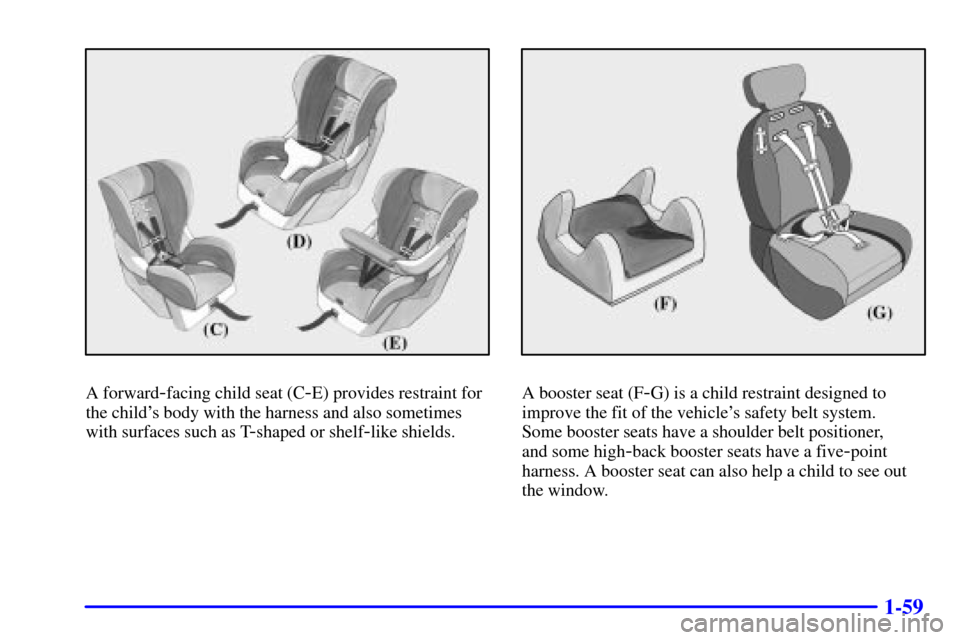
1-59
A forward-facing child seat (C-E) provides restraint for
the child's body with the harness and also sometimes
with surfaces such as T
-shaped or shelf-like shields.
A booster seat (F-G) is a child restraint designed to
improve the fit of the vehicle's safety belt system.
Some booster seats have a shoulder belt positioner,
and some high
-back booster seats have a five-point
harness. A booster seat can also help a child to see out
the window.
Page 72 of 436
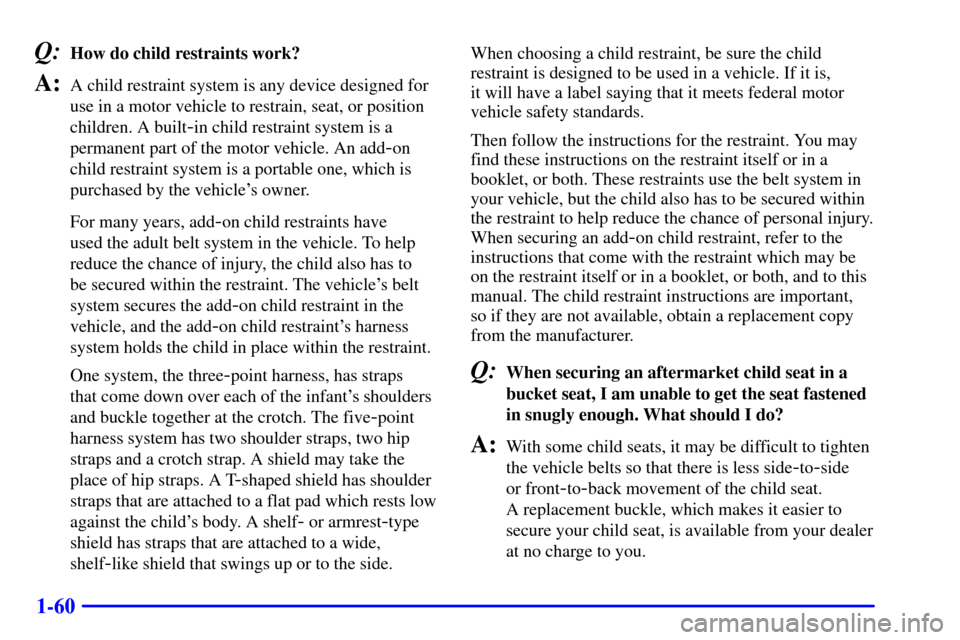
1-60
Q:How do child restraints work?
A:A child restraint system is any device designed for
use in a motor vehicle to restrain, seat, or position
children. A built
-in child restraint system is a
permanent part of the motor vehicle. An add
-on
child restraint system is a portable one, which is
purchased by the vehicle's owner.
For many years, add
-on child restraints have
used the adult belt system in the vehicle. To help
reduce the chance of injury, the child also has to
be secured within the restraint. The vehicle's belt
system secures the add
-on child restraint in the
vehicle, and the add
-on child restraint's harness
system holds the child in place within the restraint.
One system, the three
-point harness, has straps
that come down over each of the infant's shoulders
and buckle together at the crotch. The five
-point
harness system has two shoulder straps, two hip
straps and a crotch strap. A shield may take the
place of hip straps. A T
-shaped shield has shoulder
straps that are attached to a flat pad which rests low
against the child's body. A shelf
- or armrest-type
shield has straps that are attached to a wide,
shelf
-like shield that swings up or to the side.When choosing a child restraint, be sure the child
restraint is designed to be used in a vehicle. If it is,
it will have a label saying that it meets federal motor
vehicle safety standards.
Then follow the instructions for the restraint. You may
find these instructions on the restraint itself or in a
booklet, or both. These restraints use the belt system in
your vehicle, but the child also has to be secured within
the restraint to help reduce the chance of personal injury.
When securing an add
-on child restraint, refer to the
instructions that come with the restraint which may be
on the restraint itself or in a booklet, or both, and to this
manual. The child restraint instructions are important,
so if they are not available, obtain a replacement copy
from the manufacturer.
Q:When securing an aftermarket child seat in a
bucket seat, I am unable to get the seat fastened
in snugly enough. What should I do?
A:With some child seats, it may be difficult to tighten
the vehicle belts so that there is less side
-to-side
or front
-to-back movement of the child seat.
A replacement buckle, which makes it easier to
secure your child seat, is available from your dealer
at no charge to you.
Page 73 of 436
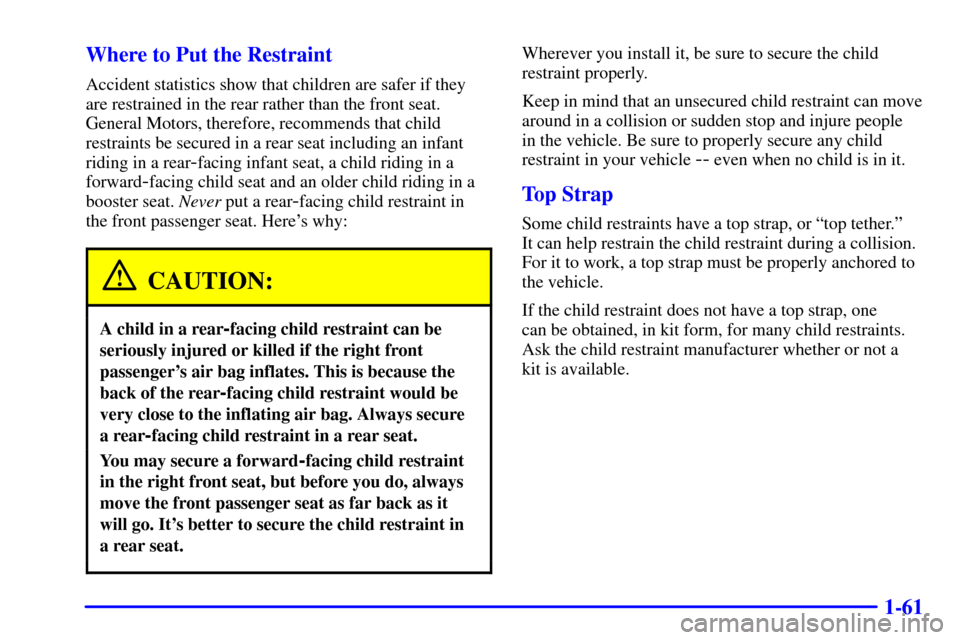
1-61 Where to Put the Restraint
Accident statistics show that children are safer if they
are restrained in the rear rather than the front seat.
General Motors, therefore, recommends that child
restraints be secured in a rear seat including an infant
riding in a rear
-facing infant seat, a child riding in a
forward
-facing child seat and an older child riding in a
booster seat. Never put a rear
-facing child restraint in
the front passenger seat. Here's why:
CAUTION:
A child in a rear-facing child restraint can be
seriously injured or killed if the right front
passenger's air bag inflates. This is because the
back of the rear
-facing child restraint would be
very close to the inflating air bag. Always secure
a rear
-facing child restraint in a rear seat.
You may secure a forward-facing child restraint
in the right front seat, but before you do, always
move the front passenger seat as far back as it
will go. It's better to secure the child restraint in
a rear seat.
Wherever you install it, be sure to secure the child
restraint properly.
Keep in mind that an unsecured child restraint can move
around in a collision or sudden stop and injure people
in the vehicle. Be sure to properly secure any child
restraint in your vehicle
-- even when no child is in it.
Top Strap
Some child restraints have a top strap, or ªtop tether.º
It can help restrain the child restraint during a collision.
For it to work, a top strap must be properly anchored to
the vehicle.
If the child restraint does not have a top strap, one
can be obtained, in kit form, for many child restraints.
Ask the child restraint manufacturer whether or not a
kit is available.
Page 74 of 436
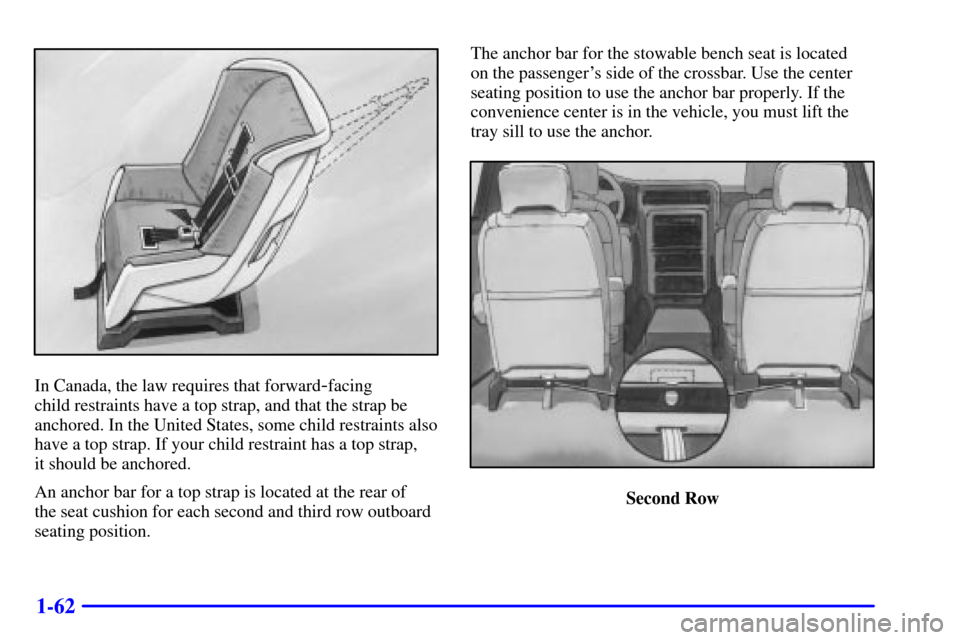
1-62
In Canada, the law requires that forward-facing
child restraints have a top strap, and that the strap be
anchored. In the United States, some child restraints also
have a top strap. If your child restraint has a top strap,
it should be anchored.
An anchor bar for a top strap is located at the rear of
the seat cushion for each second and third row outboard
seating position.The anchor bar for the stowable bench seat is located
on the passenger's side of the crossbar. Use the center
seating position to use the anchor bar properly. If the
convenience center is in the vehicle, you must lift the
tray sill to use the anchor.
Second Row
Page 75 of 436
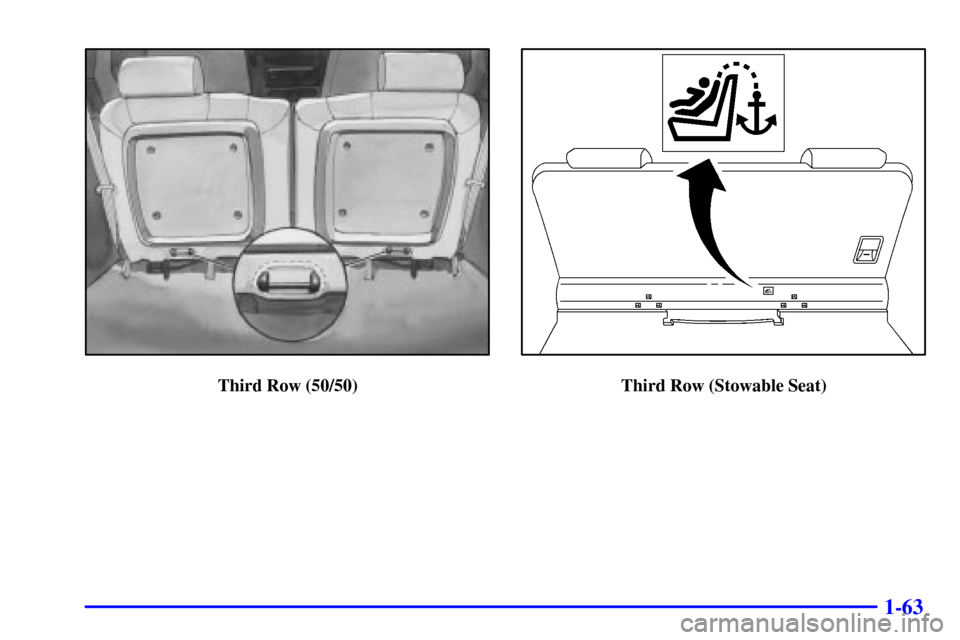
1-63
Third Row (50/50)Third Row (Stowable Seat)
Page 76 of 436
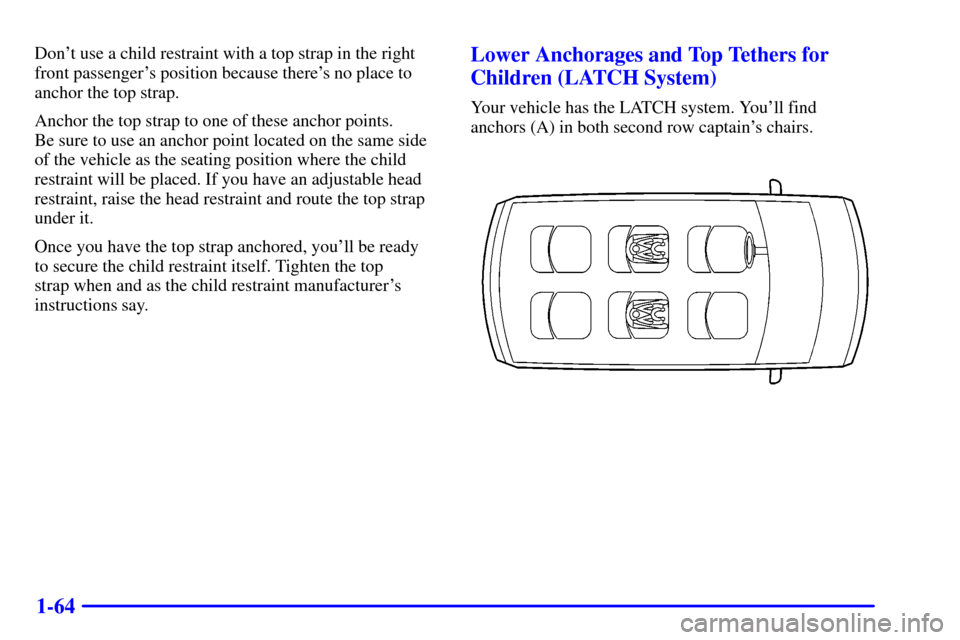
1-64
Don't use a child restraint with a top strap in the right
front passenger's position because there's no place to
anchor the top strap.
Anchor the top strap to one of these anchor points.
Be sure to use an anchor point located on the same side
of the vehicle as the seating position where the child
restraint will be placed. If you have an adjustable head
restraint, raise the head restraint and route the top strap
under it.
Once you have the top strap anchored, you'll be ready
to secure the child restraint itself. Tighten the top
strap when and as the child restraint manufacturer's
instructions say.Lower Anchorages and Top Tethers for
Children (LATCH System)
Your vehicle has the LATCH system. You'll find
anchors (A) in both second row captain's chairs.
Page 77 of 436
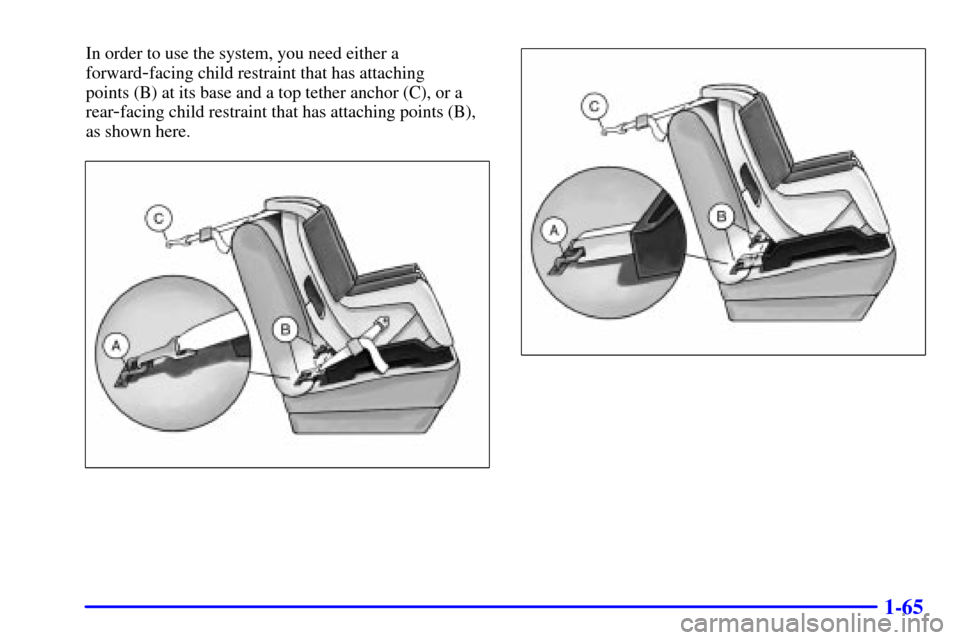
1-65
In order to use the system, you need either a
forward
-facing child restraint that has attaching
points (B) at its base and a top tether anchor (C), or a
rear
-facing child restraint that has attaching points (B),
as shown here.
Page 78 of 436

1-66
With this system, use the LATCH system instead of the
vehicle's safety belts to secure a child restraint.
CAUTION:
If a LATCH-type child restraint isn't attached
to its anchorage points, the restraint won't be
able to protect a child sitting there. In a crash,
the child could be seriously injured or killed.
Make sure that a LATCH
-type child restraint
is properly installed using the anchorage points,
or use the vehicle's safety belts to secure the
restraint. See ªSecuring a Child Restraint in a
Rear Outside Seat Positionº in the Index for
information on how to secure a child restraint
in your vehicle using the vehicle's safety belts.
Page 79 of 436
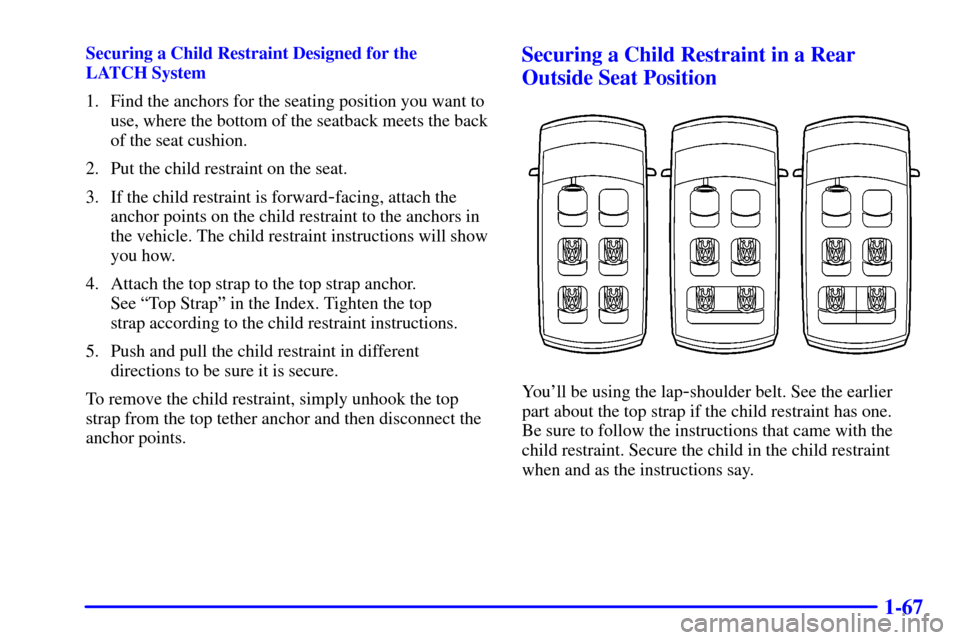
1-67
Securing a Child Restraint Designed for the
LATCH System
1. Find the anchors for the seating position you want to
use, where the bottom of the seatback meets the back
of the seat cushion.
2. Put the child restraint on the seat.
3. If the child restraint is forward
-facing, attach the
anchor points on the child restraint to the anchors in
the vehicle. The child restraint instructions will show
you how.
4. Attach the top strap to the top strap anchor.
See ªTop Strapº in the Index. Tighten the top
strap according to the child restraint instructions.
5. Push and pull the child restraint in different
directions to be sure it is secure.
To remove the child restraint, simply unhook the top
strap from the top tether anchor and then disconnect the
anchor points.
Securing a Child Restraint in a Rear
Outside Seat Position
You'll be using the lap-shoulder belt. See the earlier
part about the top strap if the child restraint has one.
Be sure to follow the instructions that came with the
child restraint. Secure the child in the child restraint
when and as the instructions say.
Page 80 of 436
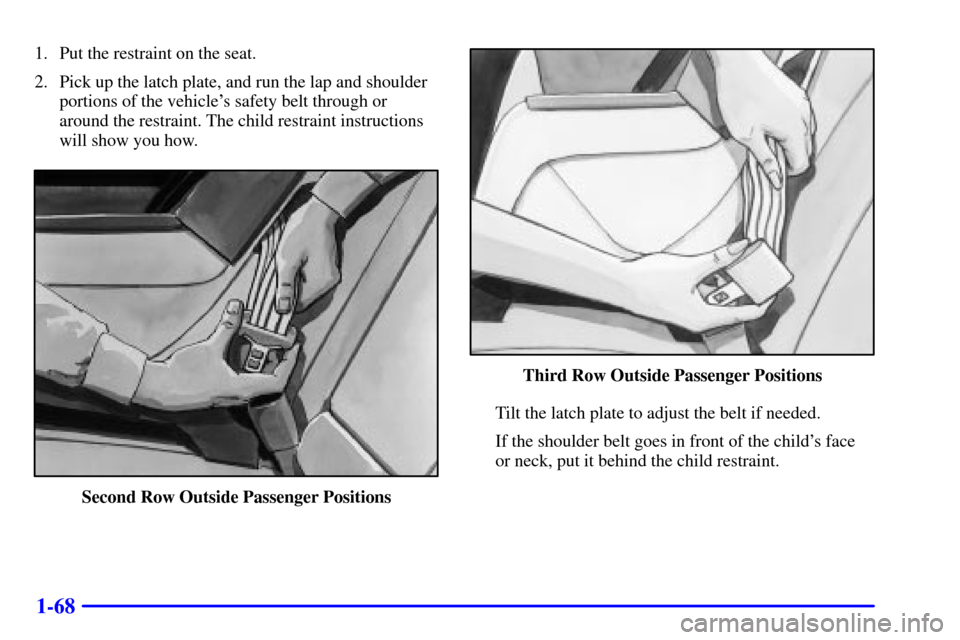
1-68
1. Put the restraint on the seat.
2. Pick up the latch plate, and run the lap and shoulder
portions of the vehicle's safety belt through or
around the restraint. The child restraint instructions
will show you how.
Second Row Outside Passenger Positions
Third Row Outside Passenger Positions
Tilt the latch plate to adjust the belt if needed.
If the shoulder belt goes in front of the child's face
or neck, put it behind the child restraint.